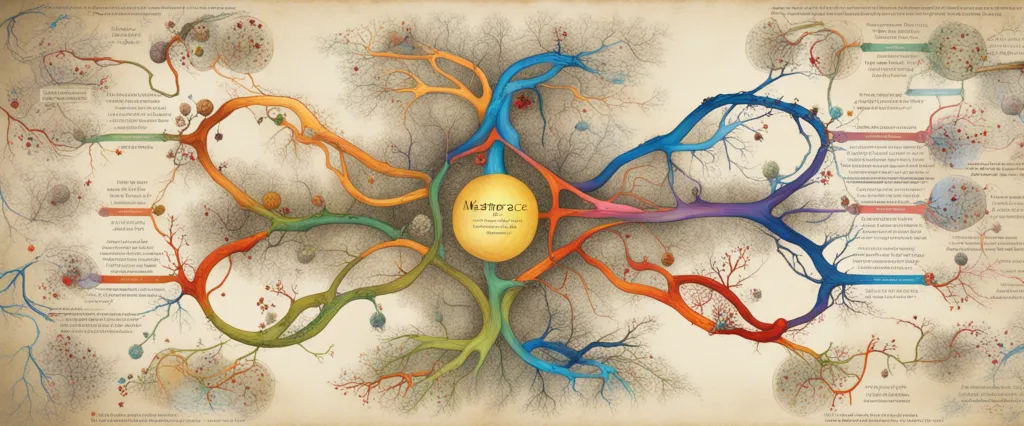In her groundbreaking book, “Mapping the Mind,” renowned science writer Rita Carter takes readers on an extraordinary journey into the mysterious realm of the human brain. With a passion for unraveling the complexities of the mind, Carter embarks on a captivating exploration of the brain’s inner workings, providing an awe-inspiring glimpse into the most intricate organ in our bodies. Drawing from a wealth of scientific research and real-life case studies, Carter sheds light on the incredible advances in neuroscience, revealing how our brain shapes our identity, emotions, perception, and consciousness. Through her engaging narrative style and expert analysis, Carter invites readers to challenge their understanding of the mind and invites them on an enlightening quest to comprehend the enigmatic landscape of the human brain.
Chapter 1: The Mysteries and Complexity of the Brain
Chapter 1: The Mysteries and Complexity of the Brain, from the book “Mapping the Mind” by Rita Carter, delves into the intricate nature of the human brain. In this chapter, Carter introduces readers to the stunning complexity of the brain and the numerous mysteries it holds.
Carter begins by explaining the sheer number of neurons in the brain, which amounts to around 100 billion, each connected to thousands of other neurons. This intricate web of connections forms the foundation of our thoughts, actions, and consciousness. The brain possesses an extraordinary ability to continuously adapt and rewire itself, allowing us to learn, remember, and navigate through the world around us.
The chapter also explores the various functions of different brain regions. It highlights how each area specializes in specific tasks, such as vision, hearing, speech, emotions, and memories. Carter introduces readers to the concept of neuroplasticity, which refers to the brain’s ability to reorganize itself based on learning and experience. This phenomenon allows for recovery from injuries and adaptation to changing environments.
Furthermore, the chapter touches on the complexity of understanding human consciousness. Despite advancements in brain imaging techniques, scientists have yet to fully comprehend how minuscule electrical and chemical signals give rise to our subjective experiences and sense of self.
Carter emphasizes the significance of mapping the brain, both in terms of understanding ourselves as individuals and uncovering potential treatments for neurological and psychiatric disorders. The chapter concludes by highlighting the immense complexity of the brain and the challenges researchers face in unraveling its mysteries.
Overall, Chapter 1 of “Mapping the Mind” provides an overview of the intricate nature of the human brain and the complex challenges involved in studying its functions and complexities.
Chapter 2: Brain Structure and Function
Chapter 2 of the book “Mapping the Mind” by Rita Carter provides an overview of the structure and function of the human brain. The chapter delves into the intricate network of neurons and the regions responsible for various cognitive abilities.
Carter begins by explaining how the brain can be divided into distinct regions, each with its own specialized functions. She explores the outer layer of the brain, known as the cerebral cortex, which is responsible for complex cognitive processes such as perception, memory, and language. The cortex is composed of four lobes: the frontal, parietal, temporal, and occipital lobes, each with its own unique roles.
Furthermore, the chapter discusses the brain’s subcortical structures, such as the thalamus and basal ganglia, which are involved in coordinating motor movements and relaying sensory information. The limbic system, which includes structures like the hippocampus and amygdala, is also explored as it plays a crucial role in emotions and memory formation.
Carter highlights the importance of communication within the brain through neural pathways. She describes how information is transmitted through electrical signals between neurons and how chemical messengers called neurotransmitters facilitate this communication.
Moreover, the chapter explores the concept of brain plasticity, which refers to the brain’s ability to reorganize and adapt throughout life. Carter discusses how experiences and learning can physically alter the structure of the brain, allowing for the acquisition of new skills or recovery from brain damage.
In conclusion, Chapter 2 provides a comprehensive overview of the brain’s structure and function. It highlights the specialized functions of various brain regions, the importance of communication between neurons, and the brain’s adaptability. Understanding these concepts is crucial for comprehending the complexities of the human mind.
Chapter 3: Mapping and Functions of the Cerebral Cortex
Chapter 3: Mapping and Functions of the Cerebral Cortex of the book “Mapping the Mind” by Rita Carter focuses on the complex organization and diverse functions of the cerebral cortex, the outer layer of the brain responsible for higher cognitive processes.
The chapter begins by emphasizing that the cerebral cortex is intricately folded, creating numerous grooves and bumps to maximize the surface area of the brain while still fitting within the skull. These convolutions allow for a greater number of neurons to be packed into a relatively small space, enabling the cortex to handle the complex tasks required for human intelligence.
The author then delves into the concept of cortical mapping, where researchers have attempted to understand the specific functions associated with different areas of the cortex. Early studies, such as those by Wilder Penfield, involved stimulating various regions of the cortex during brain surgeries and observing the resulting reactions. This research led to the identification of certain areas responsible for motor control, speech comprehension, and sensation.
Moving on, the chapter explores the concept of functional specialization, which suggests that each region of the cortex has a unique role to play in mental processes. For example, the primary visual cortex, located in the occipital lobe, is responsible for processing visual information, while the prefrontal cortex, in the frontal lobe, is involved in decision-making and executive functions. However, the author also notes that the brain is highly interconnected, and multiple regions often work collaboratively to perform complex tasks.
The chapter concludes by highlighting the plasticity of the cortical map, the ability of the brain to reorganize itself in response to damage or new experiences. This flexibility allows for recovery from brain injuries, as other regions can take over the functions of damaged areas. Furthermore, cortical mapping research has revealed the potential for brain-machine interfaces, where paralyzed individuals can regain control over their movements through direct cortical stimulation.
In summary, Chapter 3 of “Mapping the Mind” provides an overview of cortical mapping studies, emphasizing the intricate organization and diverse functions of the cerebral cortex. It explores the concept of functional specialization while acknowledging the brain’s interconnectedness. Additionally, it highlights the plasticity of the cortical map and its implications for brain recovery and advancements in neurological research.
Chapter 4: The Enigma of Sensation and Perception

Chapter 4: The Enigma of Sensation and Perception from the book “Mapping the Mind” by Rita Carter delves into our complex sensory systems and explores how our brain interprets and processes sensory information.
Carter begins by highlighting the dynamic nature of our senses, explaining how our perception of the world is not a direct reflection of reality but rather a construct created by our brains. She discusses the role of our sensory organs as the first step in this process, taking visual perception as an example. The eyes receive light information, converting it into electrical signals that travel to the brain for interpretation. Similarly, our other senses, such as touch and hearing, have their own intricate systems of sensory organ and neural pathways.
The author then introduces the idea of “sensory thresholds” and how our brains filter out irrelevant information to prevent sensory overload. Carter explains how our brains prioritize certain stimuli, allowing us to focus on what is essential while disregarding the rest. She explores various illusions and perceptual paradoxes that highlight the mechanisms our brains utilize to interpret sensory input.
The chapter further explores the connection between sensation and perception, discussing how our brains construct meaning from sensory information. Through parallel processing, our brains integrate information from multiple senses to create a cohesive experience of the world around us.
Furthermore, Carter explores the fascinating phenomenon of synesthesia, where one sensory experience triggers the perception of another. She explains how synesthetes may see numbers as colorful or associate specific sounds with different tastes, providing examples that shed light on the diverse ways in which our brains can interpret sensory input.
In conclusion, Chapter 4 of “Mapping the Mind” explores the intricacies of sensation and perception. It reveals how our sensory systems and brain work together to create our unique experience of the world, emphasizing the remarkable complexity and flexibility of our perception.
Chapter 5: The Mysteries of Memory and Learning
Chapter 5: The Mysteries of Memory and Learning explores the remarkable phenomena of memory and learning, which are essential functions of the brain that shape our perception and understanding of the world. Rita Carter delves into the intricate workings of the brain’s memory systems and their intriguing abilities.
The chapter begins by discussing learning and how it is essentially the process of modifying neural connections in the brain. Carter highlights that the brain can adapt and reorganize itself in response to new experiences and knowledge. She explains the roles of neurons, synapses, and neurotransmitters in facilitating learning and memory formation.
Carter then introduces the concept of “working memory,” the mental workspace that enables us to hold and manipulate information temporarily. She explains that working memory is limited in capacity and duration, which is why we often forget things shortly after encountering them. However, she also explores various strategies and techniques to strengthen working memory and improve cognitive performance.
The author then delves into the intriguing field of long-term memory, where memories are stored for a more extended period. She discusses the different types of long-term memory, such as explicit (conscious) and implicit (unconscious) memory. Additionally, she explores the mechanisms behind memory retrieval and how memories can be influenced by factors like emotions and context.
Carter also ventures into the realm of forgetting, explaining that it is not merely a failure of memory but a vital process that filters out unimportant information. She explores the importance of sleep in memory consolidation, highlighting how sleep deprivation can impair learning and memory functioning.
The chapter concludes by touching upon the fascinating phenomenon of memory distortions and false memories, showcasing how memories can be highly malleable and subject to biases and influences.
Overall, Chapter 5 sheds light on the complexities of memory and learning, providing a captivating exploration of the brain’s mechanisms for acquiring and retaining information.
Chapter 6: Neuroscience of Emotions and Feelings
Chapter 6 of “Mapping the Mind” by Rita Carter explores the neuroscience behind emotions and feelings. It delves into how the brain processes and produces emotional experiences, highlighting the intricate interplay between the limbic system, the prefrontal cortex, and the autonomic nervous system.
Carter begins by elucidating the various theories on the primary locations of emotions in the brain. She delves into the role of the amygdala, emphasizing its crucial function in processing fear and other intense emotions. Furthermore, she discusses the hippocampus’s involvement in memory and its influence on emotional responses. Carter also sheds light on the prefrontal cortex’s contribution to emotional regulation, decision-making, and empathy.
The chapter explores the physiological aspects of emotions by examining the autonomic nervous system’s role, which governs bodily responses like heart rate, sweating, and digestion. The author explains how emotional responses are intricately linked to this system due to its control over various bodily functions.
Additionally, the chapter delves into the role of neurotransmitters and hormones in regulating emotions. It examines the impact of chemicals such as serotonin, dopamine, and oxytocin on mood and emotional states, while also discussing their relevance to mental health conditions like depression and anxiety.
Carter concludes the chapter by exploring how emotions are represented and interpreted in the brain. She highlights the concept of emotional intelligence, the ability to recognize and understand emotions in oneself and others, and discusses its significance in interpersonal relationships and overall well-being.
In summary, Chapter 6 of “Mapping the Mind” provides an insightful overview of the neuroscience underlying emotions and feelings. It explores the key brain regions involved in emotional processing, the influence of the autonomic nervous system, and the role of neurotransmitters and hormones. This chapter offers a comprehensive understanding of the brain’s complex mechanisms and their impact on emotional experiences.
Chapter 7: Neurological Disorders and Conditions
In Chapter 7 of “Mapping the Mind” by Rita Carter, the focus shifts towards exploring various neurological disorders and conditions that affect the brain and the mind. The chapter delves into the underlying causes, symptoms, and treatments of these disorders, shedding light on the intricate workings of the human brain.
The chapter begins by discussing the several types of movement disorders, such as Parkinson’s disease, which is characterized by tremors, rigidity, and difficulty in initiating voluntary movements. Huntington’s disease, on the other hand, causes uncontrolled movements and cognitive decline. Carter also highlights the fascinating phenomenon of tics, seen in conditions like Tourette’s syndrome, emphasizing the link between these involuntary movements and activation patterns in the basal ganglia.
Moving to cognitive disorders, the chapter explores memory impairment in amnesia, drawing a distinction between retrograde and anterograde amnesia. It delves into the case of the famous patient H.M., who underwent a radical surgery to alleviate epilepsy but consequently experienced severe memory deficits. Alzheimer’s disease is then examined, highlighting the progressive nature of the condition, typically characterized by memory loss, confusion, and personality changes.
Additionally, psychiatric disorders such as depression and anxiety are explored in their neurological contexts. Carter uncovers the involvement of neurotransmitters like serotonin and norepinephrine in regulating mood, discussing the efficacy of various therapeutic options, including medication and cognitive-behavioral therapy.
The chapter concludes by discussing the intriguing phenomenon of phantom limb pain, explaining how the brain’s plasticity and sensory feedback loops can contribute to the persistence of pain sensations even after limb amputations.
Overall, Chapter 7 provides a comprehensible overview of several important neurological disorders and conditions, capturing the complexities of the brain and the impact of these conditions on the mind-body connection.

Chapter 8: Future Perspectives in Brain Research
Chapter 8: Future Perspectives in Brain Research of the book “Mapping the Mind” by Rita Carter provides a glimpse into the exciting prospects and potential of brain research. The chapter delves into the advancements that have been made so far and outlines where the field is heading.
The chapter emphasizes the growing understanding of the brain’s complexity and the significance of neural connections. It highlights the importance of deciphering how different brain regions communicate and work together to form thoughts, emotions, and behaviors. The author discusses the application of cutting-edge techniques like functional magnetic resonance imaging (fMRI) to visualize brain activity during various tasks and situations.
One of the key themes of the chapter is the challenge of understanding consciousness. Carter explores different theories and studies attempting to unravel the mysteries of consciousness, such as investigating the role of specific brain regions and studying the effects of anesthesia on the brain. There is a sense of optimism that our understanding of consciousness will continue to evolve, leading to profound insights into human nature.
The chapter also underscores the potential for brain research to revolutionize the diagnosis and treatment of neurological disorders. By identifying the underlying mechanisms and dysfunctional circuits associated with conditions like Parkinson’s and Alzheimer’s diseases, researchers hope to develop targeted therapies and interventions.
Furthermore, the chapter discusses the rise of brain-computer interfaces and neuroprosthetics, highlighting their potential to restore lost sensory and motor functions. It explores the idea of utilizing brain-computer interfaces to communicate with individuals suffering from locked-in syndrome or helping paralyzed individuals regain mobility through robotic exoskeletons.
Overall, Chapter 8 of “Mapping the Mind” provides an intriguing glimpse into the promising future of brain research. It envisions breakthroughs in our understanding of consciousness, improved treatments for neurological disorders, and the development of innovative technologies that can enhance the lives of individuals with brain-related impairments.
After Reading
In conclusion, Mapping the Mind by Rita Carter offers a fascinating exploration of the human brain and the complex web of connections that shape our thoughts, emotions, and behaviors. Through a combination of clear explanations and captivating illustrations, Carter takes readers on a journey into the intricate structures and functions of the brain, revealing the remarkable ways in which our experiences and genetics shape our minds. From understanding the role of neurons to unraveling the mysteries of memory and perception, this book provides an enlightening and comprehensive overview of our most vital organ. With its engaging writing style and wealth of information, Mapping the Mind is an invaluable resource for those interested in understanding the inner workings of the human brain.
1. The Brain that Changes Itself” by Norman Doidge: This book delves into the concept of neuroplasticity and showcases groundbreaking scientific research that reveals our brain’s remarkable ability to rewire and adapt itself throughout our lives.
2. “Phantoms in the Brain” by V.S. Ramachandran and Sandra Blakeslee: In this captivating exploration of the brain, the authors discuss bizarre neurological syndromes and present intriguing case studies that uncover the mysteries of the human mind and how it perceives the world.
3. “The Tell-Tale Brain” by V.S. Ramachandran: Building on his previous work, Ramachandran investigates the relationship between brain and behavior, addressing fascinating topics such as the origins of human language, the process of art appreciation, and the phenomenon of phantom limbs.
4. “The Man Who Mistook His Wife for a Hat” by Oliver Sacks: Known for his ability to present complex neuroscientific concepts in an accessible manner, Sacks takes readers on a captivating journey through various neurological disorders, offering compassionate insights about the human experience.
5. Thinking, Fast and Slow” by Daniel Kahneman: Although not solely focused on the brain, this book by Nobel laureate Daniel Kahneman explores the two systems that govern our thinking: the intuitive and emotional “fast” system and the logical and deliberate “slow” system. The book provides valuable insights into the quirks and biases of human cognition, shedding light on how our minds work.




